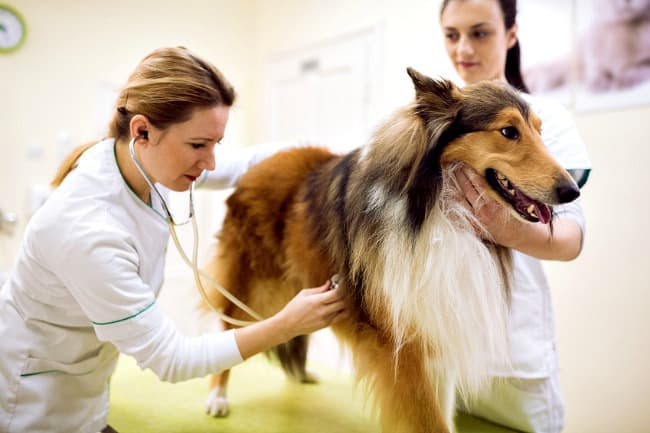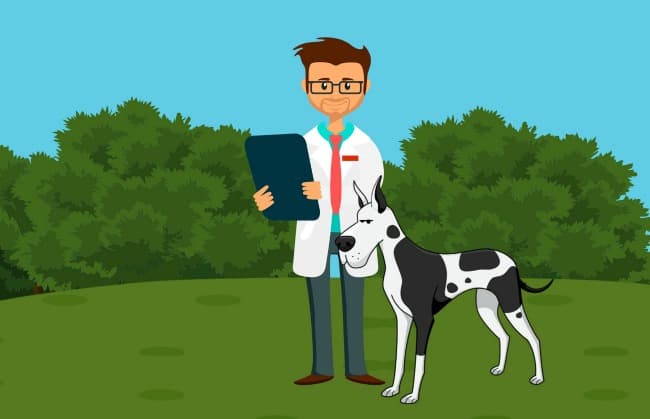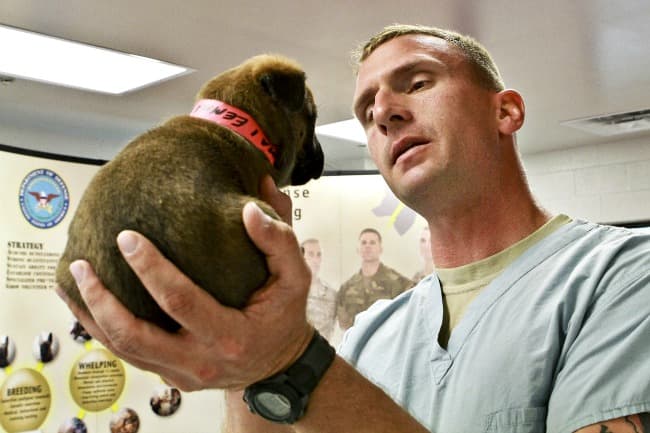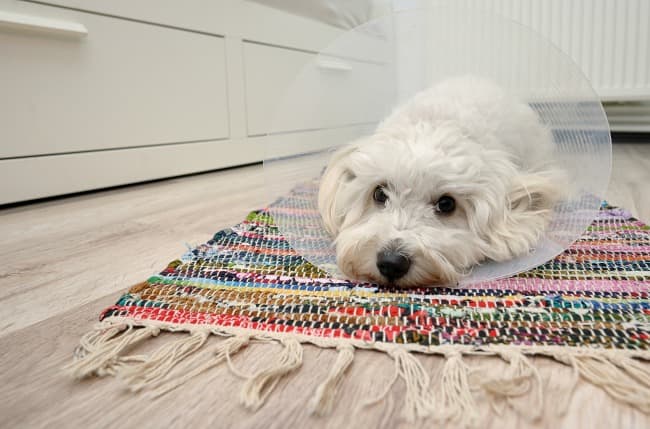FYI: If you buy something through a link on this site I may earn a commission - at NO extra cost to you.
Dog Spaying - An Owner's Guide
Dog spaying is recommended by veterinarians, dog trainers, rescue workers and animal rescue organizations everywhere and it's an important part of responsible pet ownership, and has many benefits for your dog.
The reasons for sterilization (or 'de-sexing') are mostly health related, but there are a few behavioral ones as well.
Although the majority of dog-related professionals are in agreement that this procedure is beneficial to both your pet and the dog population in general, many owners still have worries or concerns about the surgery and it's implications or side-effects.
If you're wondering if spaying your dog is really necessary, unsure
about when to have the surgery done, or concerned about after-effects,
this page has the answers you need to put your mind at rest.

All About Dog Spaying
Spaying a female dog involves removing her ovaries, fallopian tubes and uterus... all organs involved in reproduction.
This surgery is a little more complicated than the male equivalent, neutering, because it involves removing internal organs - but it is still generally a very routine procedure.
For a pup who hasn't yet had a heat-cycle and is in good health, the surgery itself usually only takes about 30 minutes.
There is no one-size-fits-all age at which it's imperative that you spay your pup, but veterinarians and researchers agree that sterilizing her before she has her first heat-cycle/season (when she ovulates) is best for a whole host of health reasons.

For small and medium sized breeds, this usually happens sometime between 5 and 6 months of age.
For larger and giant breeds, their first season may not occur until a pup is 8 to 10 months old.
Because of this difference in the rate of development, I personally don't wholeheartedly agree with the suggestion that a dog should be spayed before she's 6 months old.
Larger breeds are not nearly as mature at that age as smaller ones are and I prefer to wait until the big 'uns are around 9 months old before having them spayed.
Although vets and researchers agree that it's best for a female dog to be spayed, they don't all agree on the timing.
Some believe that there are benefits of allowing your pup to go through her first heat cycle and cite lower risk of spay-incontinence and lower incidence of mammary tumors.
Some also agree that larger breeds may benefit from being allowed to become more physically mature before the procedure.
IMPORTANT: As there are conflicting views, and data/evidence, I believe the age at which you choose to spay your pup is a personal decision and one you should make after discussing it with your own veterinarian and doing your own research!
The Advantages of Spaying Your Dog
Most of the reasons behind the push to spay your pup before she's sexually mature are health-related, but there are a few behavioral ones as well.
Then there's also the more wide-reaching positive effect on the dog population which is achieved by reducing the number of unplanned litters born every day.
Let's take a closer look at the pros of dog spaying:
- Boosts longevity. Research has shown that an 'altered' dog (ie. a spayed female, or neutered male) has the potential to live up to 3 years longer than one who hasn't been sterilized. Considering the average lifespan of a dog is anywhere from 9 - 15 years (depending on size, breed and general health), that's quite significant.
- Reduces reproductive order diseases. This procedure eliminates certain reproductive order conditions such as cancers, uterine disorders, cysts and infections. Many of which are very serious, and cancerous ones are often fatal. Removing these organs eliminates these risks because she can't get cancer in an organ she no longer has in her body!
- Reduces hormone-related conditions. There are also several hormone-related conditions (including breast cancer, phantom pregnancies, ovarian cysts, skin and coat problems and many more) whose threat is significantly decreased by the drop in hormone levels after spaying.
- Protects against pregnancy/labor complications. Although dog pregnancy and whelping are normal functions, they are definitely not risk free! By removing your pet's ability to have puppies you are protecting her from these dangers.
- Reduces hormone-related behavior problems. Due to the hormone surges a sexually mature female dog experiences at certain times, there can be all sorts of behavior problems including dominance, territorial behavior, aggression (most likely dog-to-dog but it can potentially extend to humans at times), fighting, excessively affectionate behavior, compulsive actions, wandering and roaming etc. Although spaying your dog won't turn a bossy, aggressive girl into a laid-back sweetheart (unless her hormones are totally out of whack!) it will reduce or even remove most of these behaviors.
- Eliminates practical problems. There are practical disadvantages to having a dog who comes into season twice a year (this is average, some dogs will have a heat-cycle only once a year, others three times - breed and genes play a role). She will bleed for about 10 days of the approx. 3 weeks she's in season. It could be more, could be less. She'll also be highly attractive to ANY male dog within what seems like a 20 mile radius! Both of these problems can make life messy, difficult and inconvenient for everyone... spaying her eliminates them all :)
Apart from the benefits to your pet specifically, dog spaying has some very significant benefits to dogs as a whole.
- Reduces the number of unwanted puppies being born. There are millions of unwanted puppies and dogs in shelters and pounds, and a huge number of them are euthanized because they can't find a forever home quickly enough. This is a tragedy of huge proportions.
While you may love your dog to pieces, and do your best to find homes for an unwanted litter of puppies... there's no way to be sure that these little ones won't end up neglected or surrendered somewhere down the line. So, why risk adding to the problem? Spay your dog and save a whole lot of heartache. - Helps lower stray-transmitted disease figures. Fewer strays also reduces the risks of diseases being spread by unvaccinated dogs and these illnesses are a direct threat to all puppies and dogs - including yours!
The Disadvantages of Dog Spaying
Although everything points to the fact that the 'pros' of sterilizing your dog definitely outweigh the 'cons', there are some disadvantages that you need to know about. These include:
- Potential post-surgical weight gain. A female who has been spayed often gains weight more easily than she did before the surgery, so you need to keep an eye on this. The reduction of hormones and other internal changes lowers your pet's metabolism so she burns fewer calories, and more slowly, than she did before. Giving her a little less food (our vet recommends reducing food intake by about 30%) or switching to a weight-control formula is usually enough to make sure that she doesn't get chunky!
- The effect on gender-specific characteristics. As with the worries about the link between neutering a male dog and the under-development of 'masculine characteristics' such as muscle size, head shape and so on, there is also a possibility that spaying your pup too early will limit her 'feminine characteristics'. In either sex this might be seen as a pup who never looks fully mature, always being a little more 'leggy' or lighter than average, or who behaves in an immature way. Luckily you can bypass this potential problem (and there's no real proof that it IS a problem) by making sure that you don't spay your pup too early. See section below for more on this.
- Risk of post-surgical incontinence. One of the problems that does seem to occur now and then after spaying, is incontinence. It's not terribly unusual for a just-spayed dog to leak a little urine during the hours/day or two after surgery and this almost always clears up by itself as her body recovers. But, sometimes there is more long-term loss of bladder control - possibly due to the reduction in hormones or to trauma from the surgery itself.
This can be controlled with medications but it is obviously not what you want. There's no real consensus on this, but some vets and other professionals believe that neutering early (before first heat cycle) increases the risk of this problem. You need to weigh that against the increased risk of cancers and other issues if you wait until after that first heat-cycle hormone surge. There's no one-right answer and you need to discuss all of this with your vet.
As I mentioned earlier, there is some research which suggests that pups who are spayed after their first heat cycle have less incontinence problems than those spayed before becoming sexually mature. - The inherent risks of any surgery. Dog spaying is a surgical procedure, which needs a general anesthetic and there are risks involved with both of these. But a young, healthy dog who has the necessary pre-operative tests recommended by their veterinarian should do just fine and the benefits to her health outweigh the risks.
When to Spay Your Puppy or Dog
The current recommendations are to get the procedure done when a pup is between 5 and 7 months old.
This is based on two criteria:
- The risks of general anesthesia
- The age at which she reaches sexual maturity
Both of these play a role in determining what age is best to neuter your pup, but they're not set-in-stone.

Anesthetics have become much safer since these guidelines were introduced, and the breed size of your pup as well as other health-related issues need to be taken into account as well....
- As I mentioned above, general anesthesia has some inherent risks, but the medications are very safe and if your pup is young and healthy the potential dangers are minimal.In older dogs, or those with certain health problems, the risks may be greater and your vet will discuss this with you.
If he recommends pre-operative blood tests (some do this routinely, others only if they think it's necessary) I'd suggest getting them done. They're in the best interests of your dog. - What breed type and size your dog is has a direct effect on how quickly (or slowly) she reaches sexual maturity. The age recommendations are based on a small to medium sized dog, who will usually become mature somewhere around 6 months old, on average. A larger breed can take anywhere from 6 - 9 months, occasionally even longer, to reach sexual maturity.
If you're wondering whether or not you can spay your pup once she comes into season (for example you wanted to do it first, but she started before you had the surgery lined up), then the answer is 'yes, you can'.
But, the procedure is a bit more risky during her heat-cycle because of the changes that take place in the organs and the increased blood flow to the area. It's also more expensive because of that.
It's also possible to spay a dog who is pregnant, at least during the first month of pregnancy. But again, it's riskier than spaying a non-pregnant dog because of all the changes going on inside her. Again, more expensive too.
Personally, I wouldn't want to take the chance of any increased risk during surgery, but it's a personal decision and you need to take into account all the facts in your own situation before making a decision.
After-Effects & Possible Complications
Spaying your dog is a common, routine procedure and the vast majority of puppies and dogs sail through it with absolutely no major problems, either during or afterwards.
But it IS surgery, so of course there is some pain or discomfort and things that you need to be on the look-out for to make sure that if a complication does occur you know how to handle it.
Pain or discomfort after spaying
Your pup has had surgery which involves an incision through both skin and muscle wall, and the removal of several internal organs... so she's going to hurt a bit.
She will most likely have been given a pain shot right after the procedure and most veterinarian's keep the pup/dog overnight to make sure she's recovering properly before allowing her to leave.
So, by the time your little girl gets home the worst of the pain will be over, and most vets will send you home with pain pills to help get her over the remaining discomfort.
DO NOT give your dog human-medications/painkillers, these can be very dangerous some of them fatal to dogs.
Signs and symptoms of pain in dogs include panting, pacing, whining, drooling and a general inability to settle down.
Other than the pain medication there's not a lot you can do to help your dog, other than give her lots of TLC and be patient and understanding if she's a bit grouchy or clingy.
Alternating hot and cold compresses can help reduce swelling and pain, but many dogs won't tolerate you messing with their 'sore parts' and if it upsets her for you to try it's best just to leave well alone.
Luckily this phase doesn't last very long and dogs are very resilient. She will likely just doze and rest for the first day or so, but after that she will be up and raring to go.
BUT, if she doesn't seem to get relief from the pain, it gets worse, or you haven't been given any pain pills for her and she's upset and uncomfortable get in touch with your vet and request them.
Swelling or redness at the site of the incision
Sometimes a dog will develop a swelling at the area of the incision itself. There are all sorts of things that can cause this and it's not unusual.
Depending on what's causing the swelling it may disappear by itself within a few days, or it might need some attention from your vet. If the swelling doesn't seem to bother your dog, isn't painful to touch and doesn't appear infected you might just want to call your vet and ask for his advice.
But, if there's any redness or pus, the area feels hot or seems especially painful when touched then there could well be an infection setting in and you need to get your dog veterinary attention right away so that you can nip it in the bud.
The 'scar' at the site of the incision may be raised, thickened and more darkly colored than the surrounding skin for several weeks after the surgery, this is normal.
It should eventually become smoother and paler, but it won't entirely disappear.
Problems at incision site
Your pup's tummy hurts and the stitches feel 'tight' and it's natural for her to lick or even bite at the area in an effort to relieve her discomfort. BUT, this is not good.

Wet skin is much more likely to become infected and biting at the incision can cause stitches to get broken or pulled out - leading to infection or an open wound.
If your dog insists on licking or 'worrying' at her incision, you'll need to get an Elizabethan collar so that she simply can't reach it. Your vet may be able to give you one of these or you can buy them at pet stores or online.
Because wet skin is prone to infection, it's also important not to bathe your dog (or allow her to swim, paddle or play in wet grass etc.) until her stitches have been removed and she's been given the 'all clear' by your veterinarian.
Lots of activity, running, rough-housing or playing can also pull out stitches which are meant to stay in place for about 2 weeks before being removed by your vet.
It's important to keep your dog as quiet and calm as possible for those two weeks.
Separate her from other dogs for the first few days, and then supervise play sessions and make them short and low-key. If necessary exercise or play with her separately and no long walks or romps at the dog park.
Complications of anesthesia
Anesthetics today are very safe and well-tolerated by the vast majority of pets, but (very) rarely a dog will have a bad reaction to the drugs used, or a pre-existing health problem will interact with the anesthesia and cause problems.
Dogs with liver or kidney problems are more at risk of this sort of complication and that's one of the reasons why the pre-op blood tests are recommended... to make sure that there are no surprises on the operating table.
Older dogs, or those with existing health problems, are more at risk than young healthy pups, and some breeds also seem to have a greater incidence of anesthesia related problems.....
These include the Beagle, Basenji, Boxer, Bull Terrier, Cairn Terrier, Collies, Doberman, Elkhound, Greyhound, Poodle, Samoyed and others.
Very tiny or teacup breeds need minuscule doses of anesthesia and some extra-large or giant breeds are very sensitive to it and need less sedation than their size would suggest.
Of course, your veterinarian is aware of all this and will make sure that all the proper precautions are taken to keep your precious pet safe.
As long as you work with your vet, make sure the necessary tests are done and follow his/her recommendations and advice your dog will do just fine.
And please, if you have one of the breeds mentioned above, do realize that it does NOT mean that she is in danger or that she shouldn't be spayed!
Your veterinarian is the expert and will do whatever is necessary to make sure all is well.
Dog Spaying - Final Thoughts
There are lots of good reasons why you should spay your dog! Her health, longevity, and behavior will benefit - and so will the general dog population.

If you keep yourself informed and discuss the procedure with your vet, following his/her advice, then you're doing everything you can to make sure that she gets all the benefits and makes a full, and speedy recovery.
If you want to know how much it's going to cost to have your pet spayed, just ask your vet.
There's no one-size-fits-all answer because although each veterinarian will have a basic price, each dog and case is individual.
It costs more to spay a bigger dog than a smaller one (just think - more anesthesia, more pain meds, more stitches etc.), more if the spay surgery is above-averagely complicated (ie if your dog is in season, pregnant, or has certain health issues).
Plus the area of the country, or world, that you live in has a big impact on the cost of veterinary care, and everything else.
On average you can expect to be looking at around $300 or more, but that's just an estimate.
There are low-cost spay and neuter clinics offered by the ASPCA. Find out what's available in your area HERE.
you might also like...
- Home
- Puppy Health Care
- Dog Spaying
FTC Disclosure: Some pages on this site contain affiliate links. I may earn on qualified purchases.





